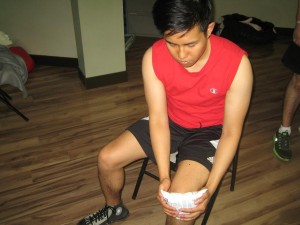The knee is the most complex of all the joints found in the body and it is an active joint and one will experience difficulty in walking if it is damage. The knee also carries the entire weight of the upper body. A knee sprain is an injury where the ligaments are overstretched and painful. Ligaments found in the knee joints are bands of tissue which function in keeping the bones of the lower and upper legs aligned and properly connected as well as providing stability to the knee.
A knee can get sprained by a sudden force or a sudden twisting and the person will experience pain, swelling and diminished range of movement.
Causes of knee sprain
- A knee sprain can be caused by an abnormal movement of the leg while playing sports such as sudden twist at the knee joint while planting the foot on the ground, thus damaging the knee ligaments. A sudden stop while running can also cause a sprained knee.
- A sudden change in the direction of the leg while landing after a jump can cause twisting and damage the ligaments of the knee.
- A sudden and sharp over-extension of the knee can also cause a knee sprain such as playing football, basketball and skiing.
- A knock or a direct hit on the knee and on any sides can cause a knee sprain or falling from a tree in an uncomfortable position can sprain the knees.

Symptoms of a knee sprain
- There is a sudden pop at the time of the injury when the anterior cruciate ligament is damaged.
- Pain is the characteristic symptom when any of these ligaments are damaged.
- There is a limited range of movement in the knee and the color of the skin around the knee becomes blue or black.
- Oftentimes, there is bruising and swelling.
- The individual has difficulty in standing on the affected leg because the knee joint becomes unstable.
Managing a knee sprain
- Rest the knee which is the most important part of the treatment and avoid putting weight on the knee.
- Apply an ice pack over the injured knee in order to relieve pain and inflammation or put ice cubes or crushed ice in a plastic bag and wrap it in a towel and place on the knee for at least 20 minutes at 4 times in a day up to 3 days.
- Compress the knee by wrapping it tightly with elastic bandage but avoid wrapping it too tight that will stop the circulation in the area.
- Lie down on the back and place 2-3 pillows below the affected knee and elevate the knee above the level of the heart in order to minimize blood flow and swelling in the knee.
- Apply a warm compress on the knee to reduce the stiffness for 20 minutes at 4 times a day.
- Provide the individual with ibuprofen in order to minimize pain and seek medical help if swelling and pain in the knee remains for more than a week.
